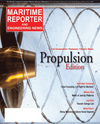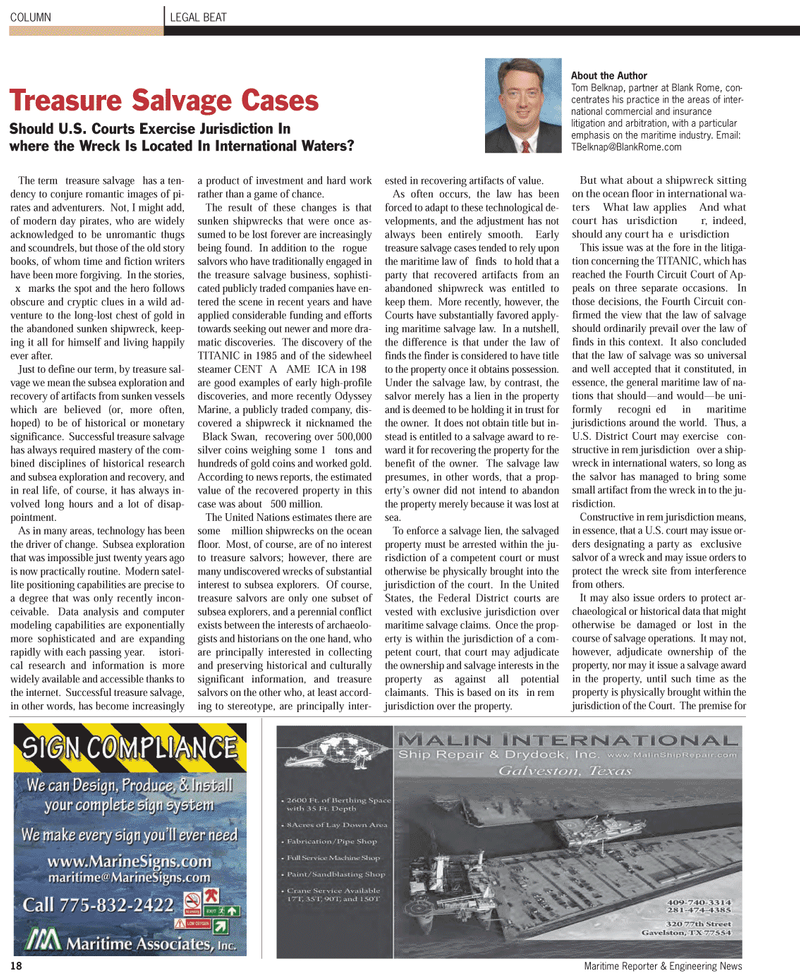
Page 18: of Maritime Reporter Magazine (September 2011)
Marine Propulsion Annual
Read this page in Pdf, Flash or Html5 edition of September 2011 Maritime Reporter Magazine
LEGAL BEAT COLUMNTreasure Salvage Cases Should U.S. Courts Exercise Jurisdiction In where the Wreck Is Located In International Waters? The term treasure salvage has a ten- dency to conjure romantic images of pi- rates and adventurers. Not, I might add, of modern day pirates, who are widelyacknowledged to be unromantic thugs and scoundrels, but those of the old story books, of whom time and fiction writers have been more forgiving. In the stories, x marks the spot and the hero follows obscure and cryptic clues in a wild ad-venture to the long-lost chest of gold in the abandoned sunken shipwreck, keep- ing it all for himself and living happily ever after. Just to define our term, by treasure sal- vage we mean the subsea exploration and recovery of artifacts from sunken vessels which are believed (or, more often, hoped) to be of historical or monetarysignificance. Successful treasure salvage has always required mastery of the com- bined disciplines of historical researchand subsea exploration and recovery, and in real life, of course, it has always in- volved long hours and a lot of disap- pointment.As in many areas, technology has been the driver of change. Subsea exploration that was impossible just twenty years ago is now practically routine. Modern satel- lite positioning capabilities are precise toa degree that was only recently incon- ceivable. Data analysis and computer modeling capabilities are exponentially more sophisticated and are expanding rapidly with each passing year. istori- cal research and information is morewidely available and accessible thanks to the internet. Successful treasure salvage, in other words, has become increasingly a product of investment and hard work rather than a game of chance.The result of these changes is thatsunken shipwrecks that were once as- sumed to be lost forever are increasingly being found. In addition to the rogue salvors who have traditionally engaged in the treasure salvage business, sophisti- cated publicly traded companies have en- tered the scene in recent years and have applied considerable funding and efforts towards seeking out newer and more dra- matic discoveries. The discovery of the TITANIC in 1985 and of the sidewheel steamer CENTA AMEICA in 198 are good examples of early high-profile discoveries, and more recently Odyssey Marine, a publicly traded company, dis- covered a shipwreck it nicknamed the Black Swan, recovering over 500,000 silver coins weighing some 1 tons and hundreds of gold coins and worked gold. According to news reports, the estimated value of the recovered property in this case was about 500 million. The United Nations estimates there aresome million shipwrecks on the ocean floor. Most, of course, are of no interest to treasure salvors; however, there are many undiscovered wrecks of substantial interest to subsea explorers. Of course, treasure salvors are only one subset of subsea explorers, and a perennial conflict exists between the interests of archaeolo- gists and historians on the one hand, whoare principally interested in collectingand preserving historical and culturallysignificant information, and treasure salvors on the other who, at least accord- ing to stereotype, are principally inter- ested in recovering artifacts of value. As often occurs, the law has been forced to adapt to these technological de-velopments, and the adjustment has not always been entirely smooth. Early treasure salvage cases tended to rely upon the maritime law of finds to hold that a party that recovered artifacts from an abandoned shipwreck was entitled to keep them. More recently, however, the Courts have substantially favored apply- ing maritime salvage law. In a nutshell, the difference is that under the law of finds the finder is considered to have title to the property once it obtains possession.Under the salvage law, by contrast, the salvor merely has a lien in the property and is deemed to be holding it in trust forthe owner. It does not obtain title but in- stead is entitled to a salvage award to re- ward it for recovering the property for the benefit of the owner. The salvage law presumes, in other words, that a prop- erty?s owner did not intend to abandon the property merely because it was lost at sea.To enforce a salvage lien, the salvaged property must be arrested within the ju-risdiction of a competent court or mustotherwise be physically brought into thejurisdiction of the court. In the United States, the Federal District courts arevested with exclusive jurisdiction over maritime salvage claims. Once the prop- erty is within the jurisdiction of a com-petent court, that court may adjudicatethe ownership and salvage interests in the property as against all potentialclaimants. This is based on its in rem jurisdiction over the property. But what about a shipwreck sitting on the ocean floor in international wa- ters What law applies And what court has urisdiction r, indeed, should any court hae urisdiction This issue was at the fore in the litiga- tion concerning the TITANIC, which has reached the Fourth Circuit Court of Ap- peals on three separate occasions. In those decisions, the Fourth Circuit con- firmed the view that the law of salvage should ordinarily prevail over the law of finds in this context. It also concluded that the law of salvage was so universal and well accepted that it constituted, inessence, the general maritime law of na- tions that should?and would?be uni- formly recognied in maritime jurisdictions around the world. Thus, a U.S. District Court may exercise con- structive in rem jurisdiction over a ship- wreck in international waters, so long as the salvor has managed to bring some small artifact from the wreck in to the ju- risdiction.Constructive in rem jurisdiction means, in essence, that a U.S. court may issue or- ders designating a party as exclusive salvor of a wreck and may issue orders to protect the wreck site from interferencefrom others.It may also issue orders to protect ar- chaeological or historical data that mightotherwise be damaged or lost in thecourse of salvage operations. It may not, however, adjudicate ownership of the property, nor may it issue a salvage award in the property, until such time as the property is physically brought within thejurisdiction of the Court. The premise for About the AuthorTom Belknap, partner at Blank Rome, con- centrates his practice in the areas of inter- national commercial and insurance litigation and arbitration, with a particular emphasis on the maritime industry. Email: [email protected] Reporter & Engineering News

 17
17

 19
19
